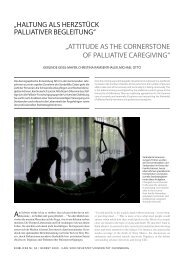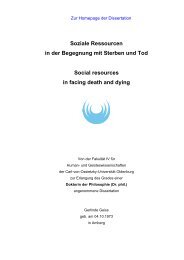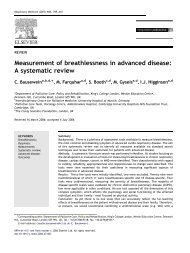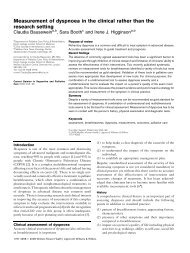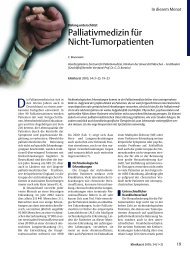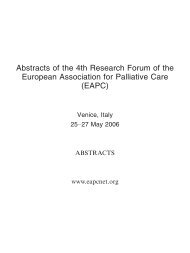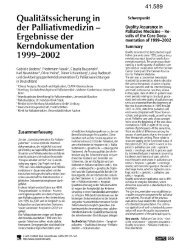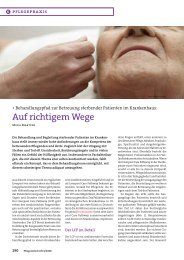EAPC - ipac
EAPC - ipac
EAPC - ipac
Create successful ePaper yourself
Turn your PDF publications into a flip-book with our unique Google optimized e-Paper software.
444 <strong>EAPC</strong> Abstracts<br />
Jason Boland University of Sheffield Sheffield UNITED KINGDOM<br />
Georgina Keenleyside University of Sheffield Sheffield UNITED KINGDOM<br />
Sophie Harrison University of Sheffield Sheffield UNITED KINGDOM<br />
Sam Ahmedzai University of Sheffield Sheffield UNITED KINGDOM<br />
Richard Stevens University of Sheffield Sheffield UNITED KINGDOM<br />
Sam Kyeremateng University of Sheffield Sheffield UNITED KINGDOM<br />
Background: There is a plethora of chronic pain assessment methods and<br />
scales that are used across a wide range of care settings. Specialist pain<br />
scoring systems are used, for example, in cancer service, pain clinics,<br />
arthritis care and nursing homes. There are also different tools for children<br />
and older people, including those with dementia. Each service uses<br />
different measures which can reduce effective communication. There<br />
should be some standardisation so that the best evidence-based measures<br />
are used consistently across services. Aims: To describe the best practice<br />
in the assessment of chronic pain in adults and older children and to make<br />
recommendations for a standardised approach for use in the UK National<br />
Health Service. The project was part of an NHS programme to engage and<br />
enable clinicians, healthcare providers and patients to share their knowledge,<br />
skills, and experiences. Methods: Two national stakeholder events<br />
have taken place. The project has sought opinions from a wide range of<br />
experts, patient representatives and professional bodies. A systematic<br />
extensive search of the literature was performed. All key documents and<br />
feedback from the events have been posted on the National Library for<br />
Palliative and Supportive Care website. An email discussion page was set<br />
up to facilitate discussion around this topic. Results: The literature review<br />
has identified over 150 pain assessment instruments. We have categorised<br />
these according to age group; cognitive functioning; body systems;<br />
disease types. Recommendations for standardised use in different settings<br />
are being disseminated for consultation. Conclusions: The assessment of<br />
chronic pain is complex and clearly requires a wide range of measures.<br />
The project has for the first time produced a comprehensive classification<br />
and sets of logical recommendations for clinicians and researchers. These<br />
now need to be widely consulted and incorporated into clinical data<br />
management systems.<br />
Poster N°: 149<br />
Type of presentation: Poster<br />
Poster session: First Group 29 May Thursday, 10.30 to 30 May Friday<br />
13.00<br />
Category: Assessment & measurement tools<br />
Title: Mini-Suffering State Examination scale: possible key criterion for<br />
6 months survival and mortality of critically ill dementia patients<br />
Authors:<br />
Bechor Zvi Aminoff Geriatric Division Sheba Medical Center,<br />
Tel-Hashomer ISRAEL<br />
Background: Six months of survival as a key criterion is extremely important<br />
for decision-making for enrolling critically ill patients to palliative settings.<br />
Prospective cohort study with 6 months of follow-up during a<br />
24-month period performed in Division of Geriatric Medicine in a tertiary<br />
general hospital. Methods: One-hundred and three consecutively admitted<br />
bedridden patients with end-stage dementia were evaluated. Patients were<br />
evaluated weekly by the Mini Suffering State Examination scale (MSSE)<br />
which developed by us and presented in world and regional congresses in<br />
Berlin (1999), Jerusalem (2000), Vancouver (2001), Stockholm (2002),<br />
Tokyo (2003), Las-Vegas (2004), Rio-de-Janeiro (2005), Madrid (2006),<br />
Saint-Petersburg (2007), the Committee for Labor, Social Services and<br />
Health of the Israeli Knesset (2005) and published in Journal Archives of<br />
Gerontology and Geriatrics (2004, 38, 2, 123–130) and Age and Ageing<br />
(2006, 35, 6, 597–601) and our book – Measurement of Suffering in endstage<br />
Alzheimer’s Disease, Dyonon, Tel-Aviv, 2007. Interrelations between<br />
Mini-Suffering State Examination score at admission and six month’s survival<br />
and mortality were evaluated. Results: A significant difference was<br />
proved among survival curves of subgroups of patients according to the<br />
mini scores (0–3, 4–6, 7–10). Survival was shorter and mortality higher in<br />
patients with a high Mini-Suffering State Examination score, as shown by<br />
the Kaplan-Meier method using the Log Rank (p=0.001) and Breslow tests<br />
(p=0.001). Conclusions: The Mini-Suffering State Examination scale is<br />
useful for predicting the last 6 months of survival and mortality of end-stage<br />
dementia patients.<br />
Poster N°: 150<br />
Type of presentation: Poster<br />
Poster session: First Group 29 May Thursday, 10.30 to 30 May Friday<br />
13.00<br />
Category: Assessment & measurement tools<br />
Title: Caregiver’s perspective of quality: development of a satisfaction tool<br />
Presenting author: Annette Welshman<br />
Authors:<br />
Francesca Bordin Palliative Care Unit Fondazione Sue Ryder Onlus ITALY<br />
Francesca Trasatti Fondazione Sue Ryder Onlus Roma ITALY<br />
Annette Welshman Fondazione Sue Ryder Onlus Roma ITALY<br />
Background: Carer satisfaction is a crucial outcome measure in Palliative<br />
Care. Satisfaction measurement tools in end of life care are few; a literature<br />
review identified 20 potential instruments for consideration in a PC<br />
setting. A 12 month pilot study in a palliative care population aimed at<br />
evaluating a new comprehensive tool was developed on the basis of a previously<br />
reported experience, in terms of usefulness and audit aims.<br />
Methods: An anonymous self-administered questionnaire was sent to the<br />
carer/family approximately 30 days following pt’s death. 20 items where<br />
chosen based on the model of FAMCARE, modified on-going in focus<br />
groups, tailored for the dying population and adapted to a home-hospice<br />
care setting: 17 are 5-point scales, and 3 Yes/No/Don’t know response<br />
options. Distinct areas of care were tested: Organisational:<br />
(accessibility/admission procedures/staff-care coordination); Technical:<br />
(competency/physical-psychological symptoms control/place of death);<br />
Relational: (respect/communication/support-family involvement in decision<br />
making); Overall satisfaction/response to expectation.; The opportunity<br />
to write feelings/advice was encouraged. Results: Response rate was<br />
58%, lower than the previous instrument used (61%), maybe due to a<br />
greater time requirement and emotional implication in filling in the form.<br />
Overall care satisfaction discriminated well between excellent 74,7%, and<br />
satisfactory 21,6%: place of death was respondent to pt/carer choice in<br />
>90%, and 96,4% reported care as fully respondent to their expectation.<br />
Separate subscale analysis revealed more satisfaction for relational than for<br />
organisational/technical aspects, showing some difficulties in “excellent”<br />
symptom control. Among relational issues, respect /attention were more<br />
satisfactory than information/communication, and the need for more specialist<br />
psychological support was underlined. Conclusion: The tool is a<br />
simple and useful audit tool; subscales evaluation and sources of “dissatisfaction”<br />
assists in planning and implementing change.<br />
Poster N°: 151<br />
Type of presentation: Poster<br />
Poster session: First Group 29 May Thursday, 10.30 to 30 May Friday<br />
13.00<br />
Category: Assessment & measurement tools<br />
Title: Validity of an average 8-hour pain intensity assessment in cancer<br />
patients<br />
Presenting author: Cinzia Brunelli<br />
Authors:<br />
Augusto Caraceni National Cancer Institute Rehabilitation and Pallliative<br />
Care Unit ITALY<br />
Ernesto Zecca National Cancer Institute Milan ITALY<br />
Cinzia Brunelli National Cancer Institute Milan ITALY<br />
Cinzia Martini National Cancer Institute Milan ITALY<br />
Giovanna Gorni National Cancer Institute Milan ITALY



